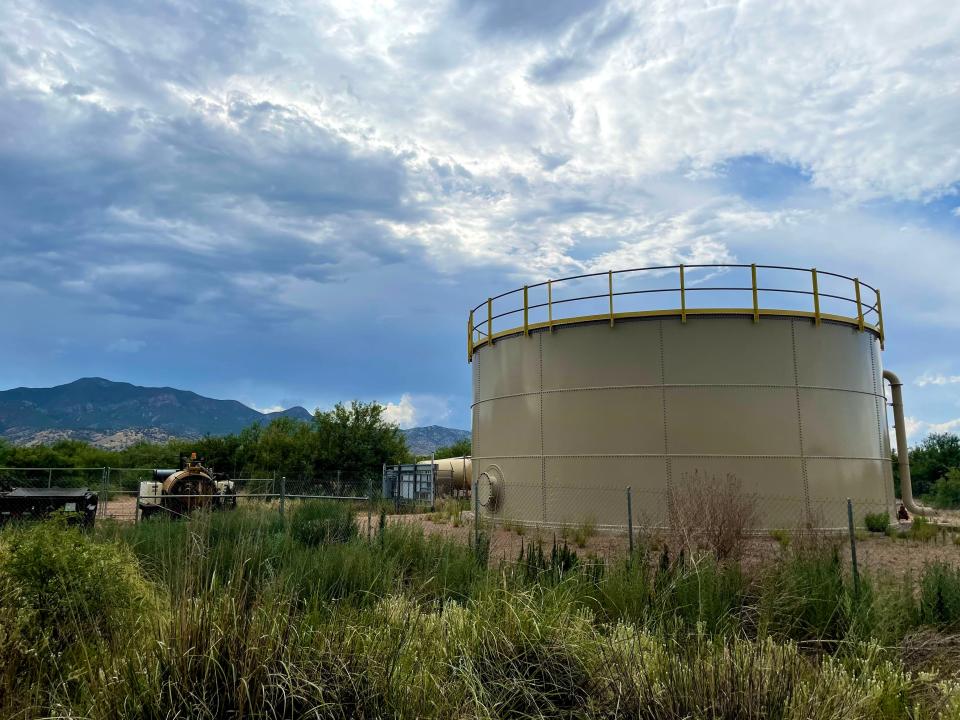'Should we be drinking the water?' Sierra Vista residents want answers about 'forever chemicals'
SIERRA VISTA — Deborah Gearty had barely heard of "forever chemicals" before she learned that they were in her drinking water.
In late April, the East Slope Water Company mailed a notice to Gearty and her neighbors informing them that PFAS, short for perfluoroalkyl and polyfluoroalkyl substances, had been detected in the water the company serves to about 450 people in the southwest corner of the city, near Ramsey Canyon.
PFAS are a broad class of manufactured chemicals, used in everything from dental floss to firefighting foam, that are highly toxic and difficult to get rid of. Research shows long-term exposure, even to low traces of these chemicals, can cause severe health issues.
Two of the contaminants were above advisory limits outlined by the Environmental Protection Agency in the distribution area west of Highway 92, known as East Slope West, the letter said. It made no mention of the potential health effects of long-term exposure or whether the company had a plan of action.
"The biggest thing it didn't say was: Should we be drinking the water?" said Gearty, who spent the following months trying to contact company representatives, gathering information from the EPA's website and organizing community meetings with neighbors to share what she learned.
In May, the company sent a second letter. PFAS levels were below the EPA proposed limit according to new tests done by both the Arizona Department of Environmental Quality and the company. So far, ADEQ can't determine the source of the contamination.
Beginning this year, ADEQ started a statewide program to test all public water systems across the state for several kinds of PFAS, using $3 million in federal funds.
At least 39 water systems in Arizona carry some PFAS above the advised limit; 60 were found below the limit. The agency sends the results to the water systems, and requests they inform customers of any PFAS detection and whether it's above or below the limit. The agency also provides information on financial opportunities to treat the water.
But the agency cannot enforce any of it, because as of today, there is no federal regulation in place for the contaminants.
The EPA proposed a national drinking water standard for six kinds of PFAS in March, after years of pressure from health practitioners and environmental professionals. The federal regulator said it expects a final rule by the end of the year at the earliest. After a rule is approved, water systems have three years to be in compliance.
Before then, there is no legal requirement to inform customers about PFAS test results or to treat the water or to find new sources.
Proposed: EPA introduces new national standards for 'forever chemicals' in drinking water
Letters offered little specific information
The letter from East Slope Water Company "was extremely non-specific," said Kevin Goodwin, a resident of the East Slope West service area. It did not contain details of the test results. Goodwin, a retired engineer, sought and studied the data on ADEQ's website to gather more information for him and his neighbors.
"It's like they were complying with some regulation that required disclosure but doing the minimum possible," he said. "I think they are just waiting for regulators to set the bar for them."
The letters from the water company were followed by silence. Gearty and Goodwin received no response from the company to calls and emails. Instead, they began a correspondence with Matthew Narter, ADEQ's PFAS lead, to try to resolve pressing questions.
Gearty said the company was unresponsive to their questions, so she began to canvass her neighborhood. With the help of her husband, she knocked on 400 doors and organized a community meeting at a local church on June 15, where she shared slides of the information she gathered from the EPA and ADEQ websites. About 100 people showed up.
Gearty said it felt like she was doing the company's job.
"I personally want the conversation to start," Gearty said. The group also put together a list of questions for the company.
"I want them (East Slope Water Company) to talk to us. Don't just say, 'Go to ADEQ.' To me, it's the company's responsibility, not (ADEQ staff) to call the meeting and tell us what PFAS is all about and what the plan of attack is."
ADEQ officials said they couldn't attend the first gathering but agreed to hold a community meeting with specialists.
Josh Uhland, operations manager with Hearthstone Water, the owner and manager of East Slope Water Company, attended too.
Uhland told attendees the company is exploring options to drill a new well in the area. The two largest-producing wells have shown no PFAS contamination. In case the distribution sites show PFAS levels above proposed EPA limits again, the company may consider taking troublesome wells out of service so they don't contaminate the rest of the water supply. There is no date yet for a third test or a follow-up meeting with customers.

PFAS levels: The lower, the better
About 60 residents gathered Tuesday night at the Rothery Educational Service Center of Sierra Vista. Staff from ADEQ and the Arizona Department of Health Services briefed those who attended on the nature of PFAS, the potential health effects, proposed regulations and test results from East Slope West.
Advisory limits for PFAS have gone from 70 parts per trillion to 4 ppt in a matter of years. It's a minuscule amount, the equivalent of four drops of water in 20 Olympic swimming pools. The desired goal is zero.
"The lower the better," repeated ADHS' epidemiologist Hsin-I Lin throughout the meeting. There is evidence that by reducing exposure, the levels of PFAS in blood decrease as well.
A person cannot get sick from drinking water with levels above the advisory limit once, she said. It's repeated exposure that can produce long-term health effects such as cancer, developmental effects and reproductive disorders.
There are also proposed limits for PFNA, PFHxS, PFBS, and GenX compounds, but they are relative. The combined limit of one or more of the chemicals would be calculated through an EPA-established hazard index.

ADEQ has tested several public water systems in Cochise County. So far, only two of them had PFAS levels above the EPA's proposed limits.
Tests with two different methods detected an average of 6.5 ppt of PFOA and 5.6 ppt of PFOS in East Slope Water West on February, and of less than 2.6 ppt of both in May.
Residents from East Slope West were skeptical of the drop in detected PFAS levels from February to May. Paula Panzino, chief science officer with ADEQ, said the results are not rare considering the company pumps a high volume of water and the blending of water between wells can bring PFAS levels down.
For East Slope West, the agency doesn't know where the contaminants are coming from, so it's hard to assign liability, ADEQ staff said.
"One of the possibilities is that in the past we have consumed and used products that contain PFAS in our households, and they have passed through our bodies and into our septic systems," Panzino said, speculating about how the contaminants could get to groundwater. Staff did not explain why this could happen in some sites like East Slope West and not in others.
Water tests also detected an average of 197 parts per trillion from PFOS and 22ppt of PFOA in water used by the Apache Generating Station, near Willcox. Most of it is used for electric power generation, but it also supplies drinking water for about 75 employees.
Arizona Electric Power Cooperative Inc. has not notified employees about the test results "as it's not a regulated constituent under the safe drinking water act," said Michelle Freeark, executive director of regulatory affairs.
AEPCO installed granulated activated carbon filters at all of the system's points of use and maintains them regularly, she said. The filters help remove 77% to 99% of PFAS chemicals, according to the EPA.
Other water systems in the county had detections for PFAS but they were below the EPA proposed limits.
Continuing worry: PFAS contamination in south Tucson challenges historic cleanup, revives health concerns
ADEQ staff said that for water with PFAS, "action is not necessary immediately," but people can reduce exposure by not using untreated water for:
drinking
cooking
washing produce
washing teeth
preparing baby formula
"It's generally safe to continue using untreated water for activities like washing dishes, showering, washing clothes, swimming or watering your yard," added an informative video produced by staff members.
The National Science Foundation offers a list of certified water filters for PFAS. The Environmental Working Group also tested 10 different types of filters for PFAS removal.
Lingering questions about health effects
Several residents at the Sierra Vista meeting expressed concerns about the lack of clarity.
"I get the feeling from everyone that we need something to do in the interim to make sure we are not taking these chemicals into our bodies," one attendee said. "Give us something to do and take while we're waiting for everybody to figure this out. We want to be proactive, but we don't have a lot to go on."
Gearty decided to get her blood tested for PFAS this year. Her concern is doctors didn't know how to read the results.
"I had to tell them what PFAS was in the first place," she said. "When the result came back for PFOA they couldn't really tell me what it meant."
Her blood results showed 5.9 nanograms per milliliter for different kinds of PFAS. According to the National Academies of Science, Engineering, and Medicine, or NASEM, there is a potential for adverse health effects when a person has over 2 ng/ml of PFAS in their blood and an increased risk if it's over 20 ng/ml.
She still doesn't know if she can attribute it to any adverse health effects.
Statewide effort: Arizona prepares to test hundreds of drinking water systems for toxic 'forever chemicals'
For about four decades, she worked for the U.S. Army. In her assignments, across the U.S., Germany and South Korea, she was mostly stationed on post, as was her husband. They have lived 23 years in Sierra Vista, four of them in Fort Huachuca. Fort Huachuca has also detected PFAS above the current EPA proposed limit.
Her blood results may be influenced by some of this history.
"But how do you pin that down, I don't know," Gearty said.
Gearty said after learning more about the "forever chemicals," she decided to replace her Teflon pans. She also installed a water filter, although she believes consumers should be reimbursed for these expenses.
"We are paying our water company to bring us water," Gearty said. "Our expectations are that the water is clean and pure. It's a basic human necessity and a right."
Clara Migoya covers environmental issues for The Arizona Republic and azcentral. Send tips or questions to clara.migoya@arizonarepublic.com.
Environmental coverage on azcentral.com and in The Arizona Republic is supported by a grant from the Nina Mason Pulliam Charitable Trust. Follow The Republic environmental reporting team at environment.azcentral.com and @azcenvironment on Facebook, Twitter and Instagram.
You can support environmental journalism in Arizona by subscribing to azcentral today.
This article originally appeared on Arizona Republic: Should water systems warn clients if they find 'forever chemicals'?

